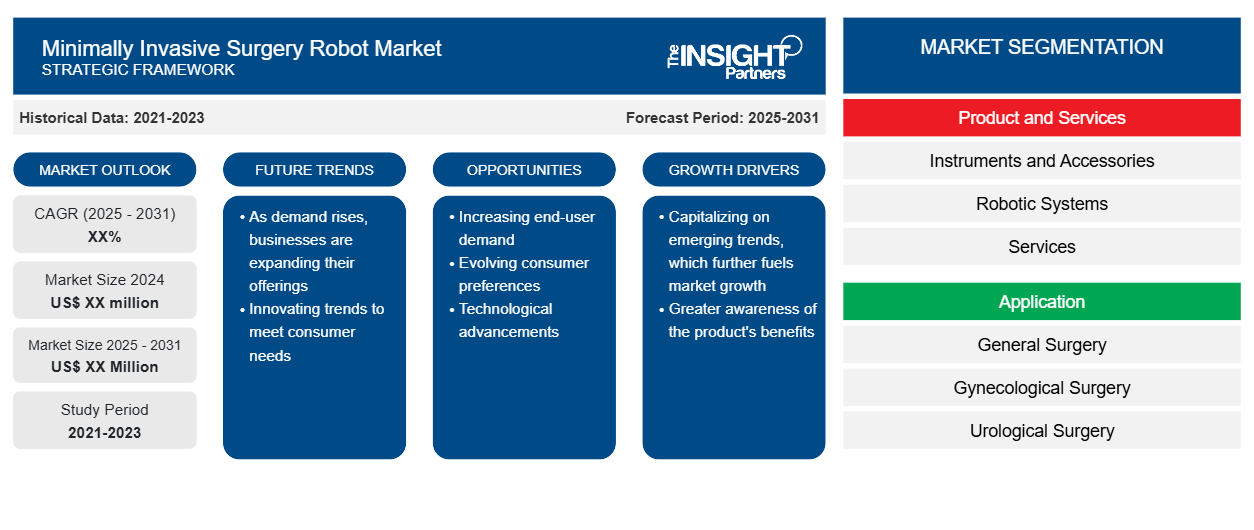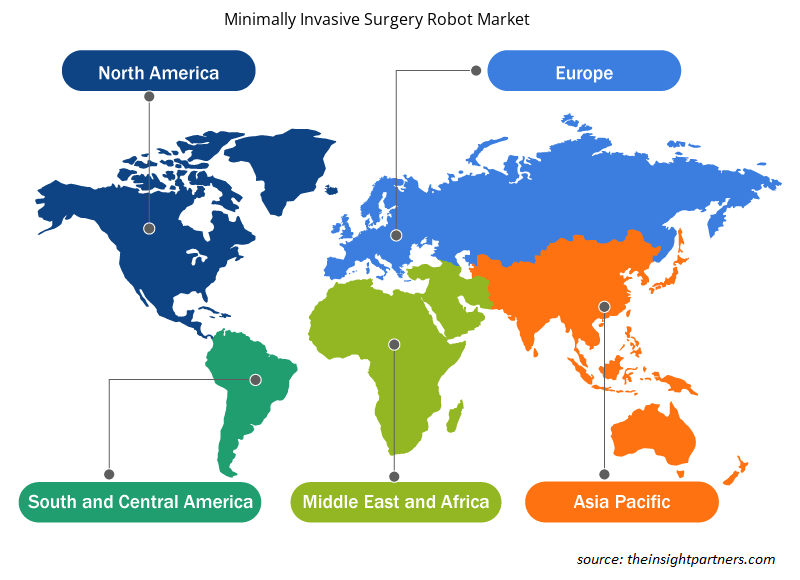微创手术机器人市场规模预计将从2024年的111.6亿美元增至2031年的291.3亿美元。预计2025年至2031年期间,该市场的复合年增长率将达到14.8%。人工智能驱动的手术辅助正在成为微创手术机器人市场的一个重要趋势。
微创手术机器人市场分析
微创手术机器人市场正经历着大幅增长,这得益于技术进步,这些进步显著增强了手术机器人的功能,并融合了高清3D可视化、增强现实和实时数据分析等功能,从而提高了手术精度和疗效。癌症、心血管疾病和肥胖症等慢性疾病的发病率不断上升,增加了对外科手术的需求,进一步推动了市场增长。此外,全球人口老龄化导致外科手术数量增加,从而扩大了对先进外科技术的需求。患者对微创手术的偏好,认为其具有术后疼痛减轻、恢复时间更快等优势,这对市场产生了积极影响。这些因素共同促进了微创手术机器人市场的持续扩张。
微创手术机器人市场概况
全球微创手术机器人市场正加速发展,这得益于慢性病发病率的上升、机器人技术的不断进步以及消费者对微创手术益处的认识不断提高。包括直觉外科 (Intuitive Surgical)、美敦力 (Medtronic) 和史赛克 (Stryker) 在内的主要市场参与者正在不断创新,以满足市场对微创手术解决方案日益增长的需求。此外,由于机器人辅助手术具有恢复时间短、疤痕减少、手术精度高以及人工智能和机器学习融入机器人系统等优势,其应用也日益广泛。由于医疗保健支出高且早期采用机器人系统,北美将在 2024 年引领市场。预计亚太地区将见证最快的增长,这得益于医疗保健投资的增加和基础设施的快速发展。
您可以免费定制任何报告,包括本报告的部分内容、国家级分析、Excel 数据包,以及为初创企业和大学提供优惠和折扣
微创手术机器人市场:战略洞察

- 获取此报告的顶级关键市场趋势。此免费样品将包括数据分析,从市场趋势到估计和预测。
微创手术机器人市场驱动因素和机遇
显微手术数量的增长促进了市场的发展
神经外科、眼科、泌尿外科、心血管外科、重建外科和其他外科领域对精准微创手术的需求日益增长。显微外科手术是一种复杂的外科手术,借助特殊仪器和显微镜来处理血管、神经或小器官等微小结构。这类手术在眼科、神经外科、耳鼻喉科、重建外科和血管外科领域非常普遍。
根据全球神经外科研究,全球每年约有 2260 万例神经外科咨询,其中 1380 万例需要手术干预。根据美国整形外科医师协会的数据,2023 年美国共进行了 157,740 例乳房重建手术,较 2020 年记录的 137,808 例显著增加。根据克利夫兰诊所的数据,在美国,血管外科医生每年进行超过 100,000 例手术和手术。最常见的血管手术类型涉及治疗外周动脉疾病 (PAD)。此外,全球每年进行约 2000 万例白内障手术,其中美国约有 370 万例。
因此,在日益增多的复杂显微手术中,外科医生对增强可视化和缩小运动的需求正在推动发达国家机器人技术的使用,并可能在未来几年推动微创手术机器人市场的增长。
新兴经济体中尚未开发的市场创造增长机会
新兴经济体为微创手术 (MIS) 机器人的推广提供了巨大的机遇。这些地区的医疗基础设施正在不断进步,政府对先进医疗技术的投资也在不断增加。
印度手术负担沉重,私营医疗行业发展迅速,为微创手术机器人带来了巨大的增长机遇。阿波罗医院、富通医疗等机构正越来越多地采用达芬奇手术系统和Versius等先进机器人平台,以提高手术精准度并改善患者预后。此外,印度政府正通过公私合作和医疗科技园区建设积极支持医疗科技生态系统。这些举措旨在提高大都市以外地区获得尖端手术工具的可及性,为二三线城市采用机器人手术开辟一条可行的途径。微创手术需求的不断增长、私营部门投资的不断增加以及越来越多的优惠政策,预计将为新兴国家的微创手术机器人市场带来巨大的潜力。
越南、菲律宾和印度尼西亚等东南亚国家正经历着人口增长和慢性病发病率上升的局面。由于该地区的医疗保健系统面临对优质外科护理日益增长的需求,各国政府正在增加医疗保健支出,并优先考虑医疗基础设施的现代化。这为采用机器人辅助手术创造了有利环境。此外,国际医疗器械公司正在通过与当地医院建立战略合作伙伴关系以及启动补贴试点项目来进入这些市场,以展示机器人平台的临床和经济效益。这些举措有助于提高认识,扩大培训能力,并为该地区长期采用 MIS 技术奠定基础。因此,新兴经济体中尚未开发的市场为 MIS 机器人提供了巨大的增长机会,这得益于不断增长的医疗保健需求、不断改善的基础设施以及采用先进外科技术的意愿不断增强,从而在预测期内为市场增长创造了丰厚的机会。
微创手术机器人市场报告细分分析
微创手术机器人市场分析的基础关键部分是产品和服务、应用和最终用途。
- 根据产品和服务,微创手术机器人市场细分为机器人系统、器械及配件以及服务。2024年,器械及配件占据了最大的市场份额。
- 根据应用领域,微创手术机器人市场可分为普通外科、妇科、泌尿外科、神经外科、骨科等。2024年,普通外科手术占据市场主导地位。
- 根据最终用途,市场分为医院、门诊手术中心和其他。2024年,医院领域占据了微创手术机器人市场的主导地位。
微创手术机器人市场份额地域分析
微创手术机器人市场报告的地理范围分为五个区域:北美、亚太地区、欧洲、中东和非洲、南美和中美。
2024 年,北美占据了相当大的市场份额。主要催化剂是该地区先进的医疗基础设施和大量的医疗支出。机器人系统的创新,例如人工智能、机器学习和增强现实的集成,提高了手术机器人的精度和功能。这些进步使外科医生能够更准确、更高效地执行复杂手术,从而促进了 MIS 机器人在各个医学专业的应用。北美,尤其是美国,医疗支出很高,并且对机器人辅助手术有优惠的报销政策。这些因素激励医院和外科中心投资先进的机器人技术,促进了 MIS 机器人的广泛应用。Intuitive Surgical、Medtronic 和 Stryker 等主要医疗机器人公司在北美拥有强大的影响力。他们持续的研发工作以及与医疗机构的合作加速了 MIS 机器人系统在该地区的应用。
微创手术机器人市场区域洞察
Insight Partners 的分析师已详尽阐述了预测期内影响微创手术机器人市场的区域趋势和因素。本节还讨论了北美、欧洲、亚太地区、中东和非洲以及南美和中美洲的微创手术机器人市场细分和地域分布。

- 获取微创手术机器人市场的区域特定数据
微创手术机器人市场报告范围
| 报告属性 | 细节 |
|---|---|
| 2024年的市场规模 | 111.6亿美元 |
| 2031年的市场规模 | 291.3亿美元 |
| 全球复合年增长率(2025-2031) | 14.8% |
| 史料 | 2021-2023 |
| 预测期 | 2025-2031 |
| 涵盖的领域 | 按产品和服务
|
| 覆盖地区和国家 | 北美
|
| 市场领导者和主要公司简介 |
|
微创手术机器人市场参与者密度:了解其对业务动态的影响
微创手术机器人市场正在快速增长,这得益于终端用户需求的不断增长,而这些需求的驱动因素包括消费者偏好的演变、技术进步以及对产品优势的认知度的提升。随着需求的增长,企业正在扩展产品线,不断创新以满足消费者需求,并抓住新兴趋势,从而进一步推动市场增长。
市场参与者密度是指特定市场或行业内企业或公司的分布情况。它表明特定市场空间内竞争对手(市场参与者)的数量相对于其规模或总市值而言。
微创手术机器人市场的主要公司有:
- 强生公司
- 史赛克公司
- 美敦力公司
- 直觉外科公司
- Asensus外科公司
- 史密斯和侄子公司
免责声明:以上列出的公司没有按照任何特定顺序排列。

- 获取微创手术机器人市场顶级关键参与者概览
微创手术机器人市场新闻及最新发展
微创手术机器人市场评估是通过收集一手资料和二手资料后进行的定性和定量数据进行的,这些数据包括重要的企业出版物、协会数据和数据库。市场的一个关键发展如下:
- 强生医疗科技宣布,MONARCH QUEST 获得美国 510(k) 监管部门批准,这是 MONARCH 导航技术的最新进展。它采用人工智能算法,并配备经过验证的 OEC Open 接口,可与 GE 医疗 OEC 3D 移动 CBCT 成像系统连接。机器人辅助支气管镜检查是美国肺活检手术中规模虽小但增长迅速的领域。MONARCH 平台是首个上市的机器人辅助支气管镜检查系统,可微创进入并可视化气道,帮助临床医生对可疑肺结节进行活检。(来源:强生服务公司,新闻稿,2025 年 3 月)
- 史赛克在拉斯维加斯举行的 2023 年美国外科医师学会年会上推出了 Mako 全膝关节 2.0,这是 Mako 智能机器人技术的最新成果。Mako 全膝关节 2.0 的设计基于超过 50 万例 Mako 全膝关节手术的经验,旨在提供外科医生对 Mako 所期待的可靠结果,并带来全新升级的用户体验。(来源:史赛克,新闻稿,2023 年 3 月)
微创手术机器人市场报告覆盖范围和交付成果
《微创手术机器人市场规模及预测(2021-2031)》报告对以下领域进行了详细的市场分析:
- 微创手术机器人市场规模及全球、区域和国家层面所有关键细分市场的预测
- 微创手术机器人市场趋势和市场动态,例如驱动因素、限制因素和关键机遇
- 详细的 PEST 和 SWOT 分析
- 微创手术机器人市场分析涵盖关键市场趋势、全球和区域框架、主要参与者、法规和最新市场发展
- 行业格局和竞争分析,包括市场集中度、热点图分析、知名参与者以及微创手术机器人市场的最新发展
- 详细的公司简介
- 历史分析(2 年)、基准年、预测(7 年)及复合年增长率
- PEST和SWOT分析
- 市场规模、价值/数量 - 全球、区域、国家
- 行业和竞争格局
- Excel 数据集
近期报告
客户评价
购买理由
- 明智的决策
- 了解市场动态
- 竞争分析
- 客户洞察
- 市场预测
- 风险规避
- 战略规划
- 投资论证
- 识别新兴市场
- 优化营销策略
- 提升运营效率
- 顺应监管趋势






















 获取免费样品 - 微创手术机器人市场
获取免费样品 - 微创手术机器人市场